Customer Acquisition Chatbot: How AI Can Revolutionize Your Lead Generation and Qualification Strategy
Home » Customer Acquisition Chatbot: How AI Can Revolutionize Your Lead Generation and Qualification Strategy
66% of consumers surveyed by HubSpot expect a live chat response within five minutes of making a query. And yet, many businesses still struggle to provide timely support, asking customers to leave their contact details in the chat, which causes friction and results in them leaving more often than not.
But while having a human support rep available at all times may not be feasible for most businesses, modern customer acquisition chatbots are becoming an accessible alternative that can fill the void of human agents and help acquire new customers completely on autopilot.
Using AI is no longer just a supplement; it’s a powerful tool that can help businesses drive customer acquisition, reduce operational costs, and improve the overall user experience.
Let’s explore everything you need to know to start using AI for customer acquisition below.
What is a customer acquisition chatbot?
A customer acquisition chatbot is a conversational AI tool programmed to proactively engage website visitors to generate and qualify leads for your business.
Unlike customer support chatbots that handle post-sale questions or troubleshooting, intelligent customer acquisition bots focus on pre-sale engagement, playing a crucial role at the top and middle of the sales funnel. One key benefit of chatbot technology in this role is its ability to automate lead generation and qualification, which traditionally required significant human involvement.
Because of this growing strategic importance, it’s not surprising that 85% of customer support and sales leaders will explore or pilot generative AI chatbots in 2025. This rapid adoption is fueled by the technology’s ability to deliver instant, contextual, and highly personalized interactions, something that no other technology can handle—and it often leads to a measurable boost in product inquiries from high-intent visitors.
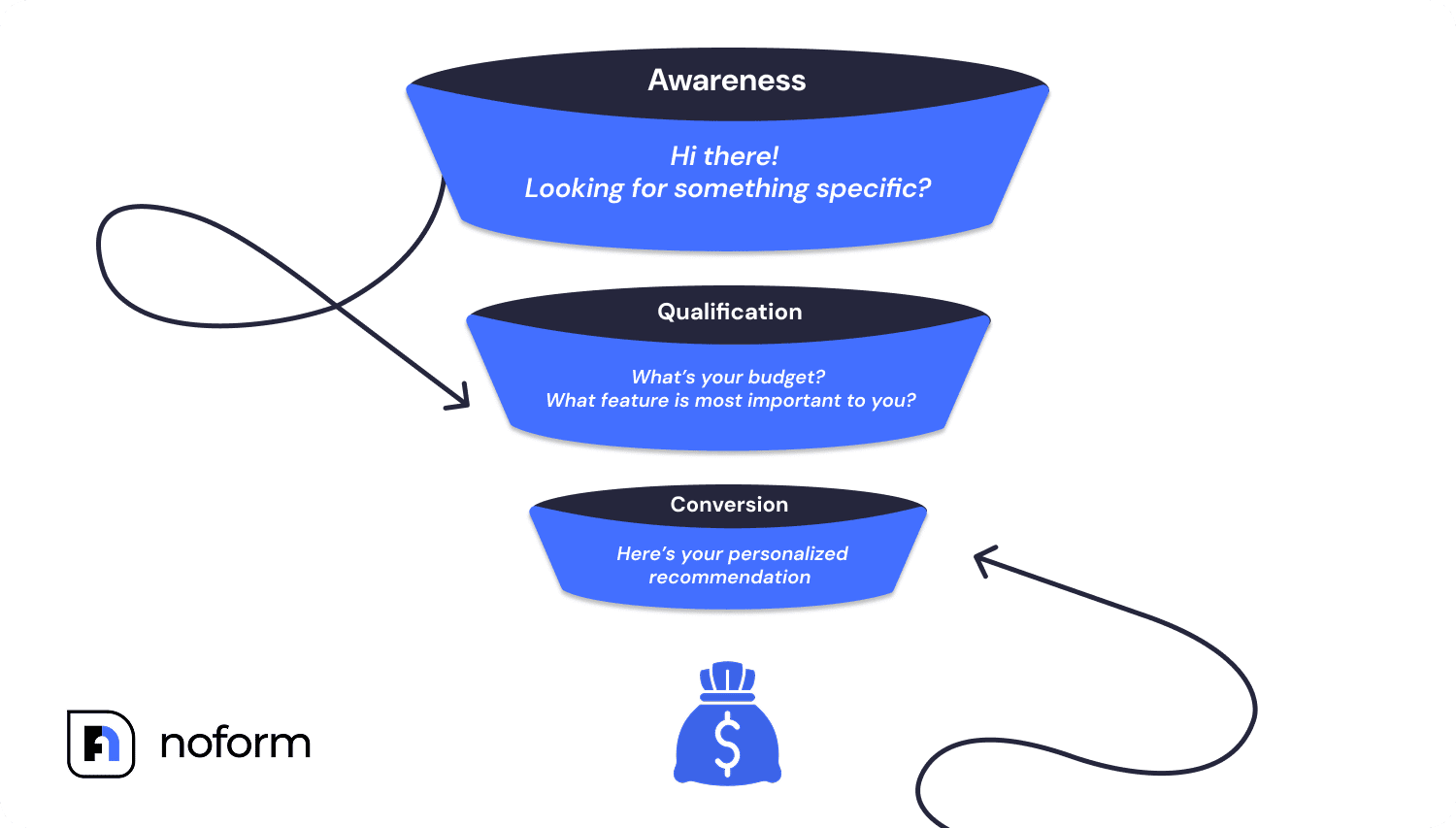
Powered by Artificial Intelligence (AI), Natural Language Processing (NLP), and automation technologies, these bots go far beyond scripted responses, understanding user intent, asking qualifying questions based on real-time behavior, and adapting conversation flows to guide users toward the next step in their customer journey.
Modern solutions like NoForm’s AI chatbot for websites also seamlessly integrate with CRM systems, allowing businesses to capture and manage lead data without adding friction to the user experience.
Key customer acquisition challenges
Acquiring customers comes with a range of challenges that used to not always have easy solutions. Here are a few of the main examples:
- Manual inefficiencies. Acquisition methods that rely on manual labor are inherently inefficient. Tasks like cold outreach, static contact forms, or manual qualification all fail to scale and are limited to the number of hours your team can allocate. For example, a sales team may spend hours following up on form submissions, even if most of them aren’t a good fit. This kind of unscalable sales effort often hinders overall efficiency.
- Higher cost per acquisition. Generating paid traffic can be very costly. It can be the single biggest contributor to high cost per acquisition, especially since conversion rates often remain stagnant. But without a way to automate interactions with people who land on your site, achieving even marginal improvements is a slow and tedious process that inflates marketing spend.
- Lead fatigue and low engagement. Today’s consumers expect conversational, real-time experiences from companies they engage with. Failing to match those expectations often leads to lead fatigue and low engagement, with delayed follow-ups causing only frustration and resulting in the leads becoming disinterested—impacting business growth over time.
- Scaling personalization. Human teams cannot realistically provide 1:1 engagement to every visitor. As your company grows, this means that the quality of engagement with leads will likely get worse unless you’re able to scale or automate your processes to support efficient resource allocation.
- Missed opportunities from delayed engagement. Without audience segmentation and AI-powered automation, businesses miss out on high-potential leads who don’t receive personalized, timely, and engaging communication from human salespeople. And as a result, a company that fails to engage visitors in real-time risks losing them to a faster competitor, increasing lost costs for companies that aren’t adapting fast enough.
- Language barriers. Businesses targeting international markets often lack multilingual support, which limits their ability to engage non-native speakers. Even if the salespeople manage to communicate, the language barrier can still serve as a hurdle that reduces clarity, causes miscommunications, and creates friction that often prevents the sale from taking place.
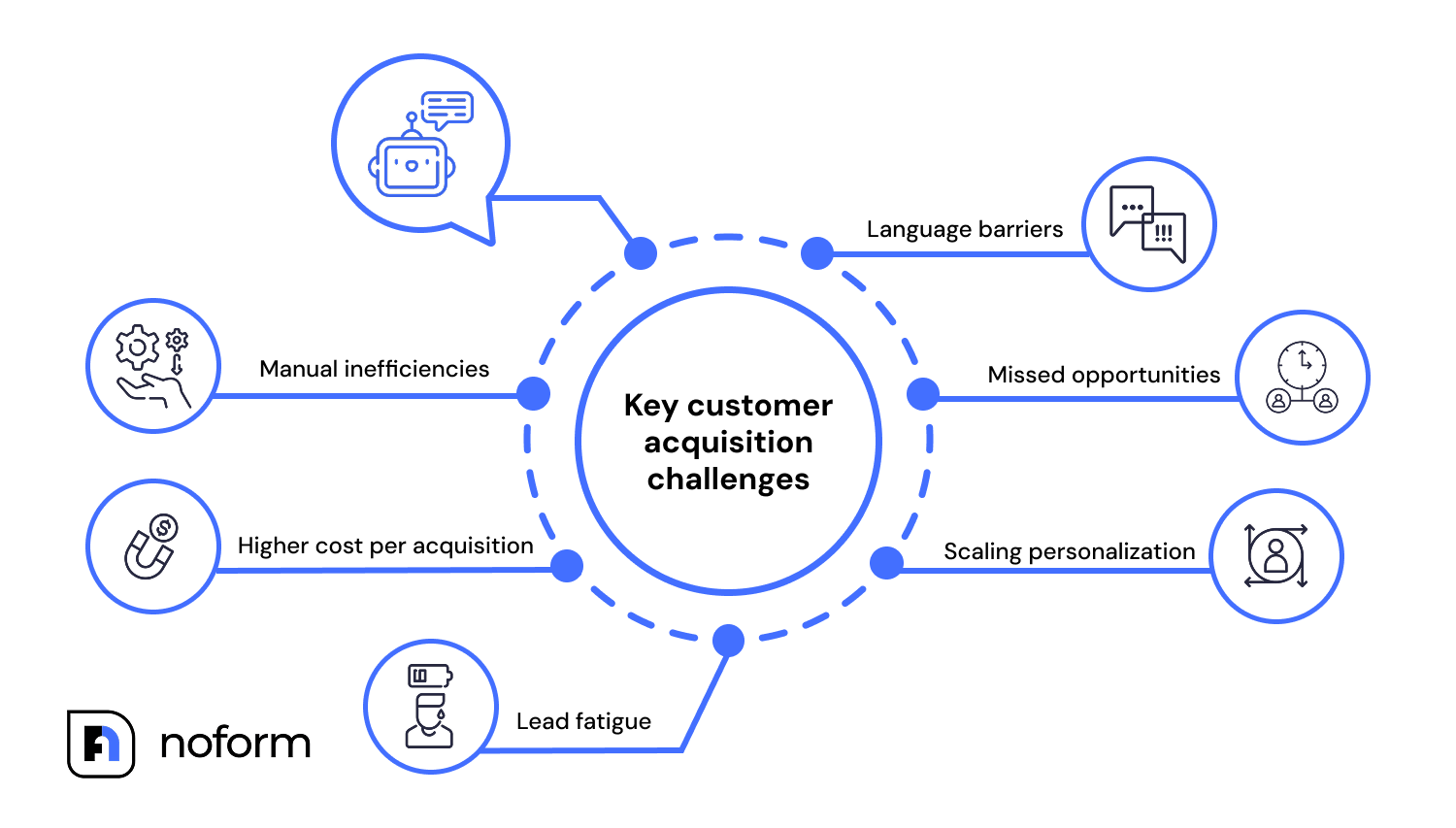
How AI-powered chatbots improve customer acquisition
The rise of AI-powered chatbots has not only changed how companies communicate with customers. The technology has solved a range of previous challenges and has helped improve every part of customer acquisition in the process.
- 24/7 availability and instant engagement: Chatbots provide instant responses to visitor queries, eliminating wait times that could turn away potential customers. They work around the clock, ensuring global coverage across time zones without additional human resources.
- Automated lead generation and qualification: Modern chatbots like NoForm’s WordPress chatbot can greet visitors, ask qualifying questions, and capture leads without the need for any manual input from your team. They can act as a salesperson who engages visitors, collects essential information, and guides them forward until your human reps are ready to step in.
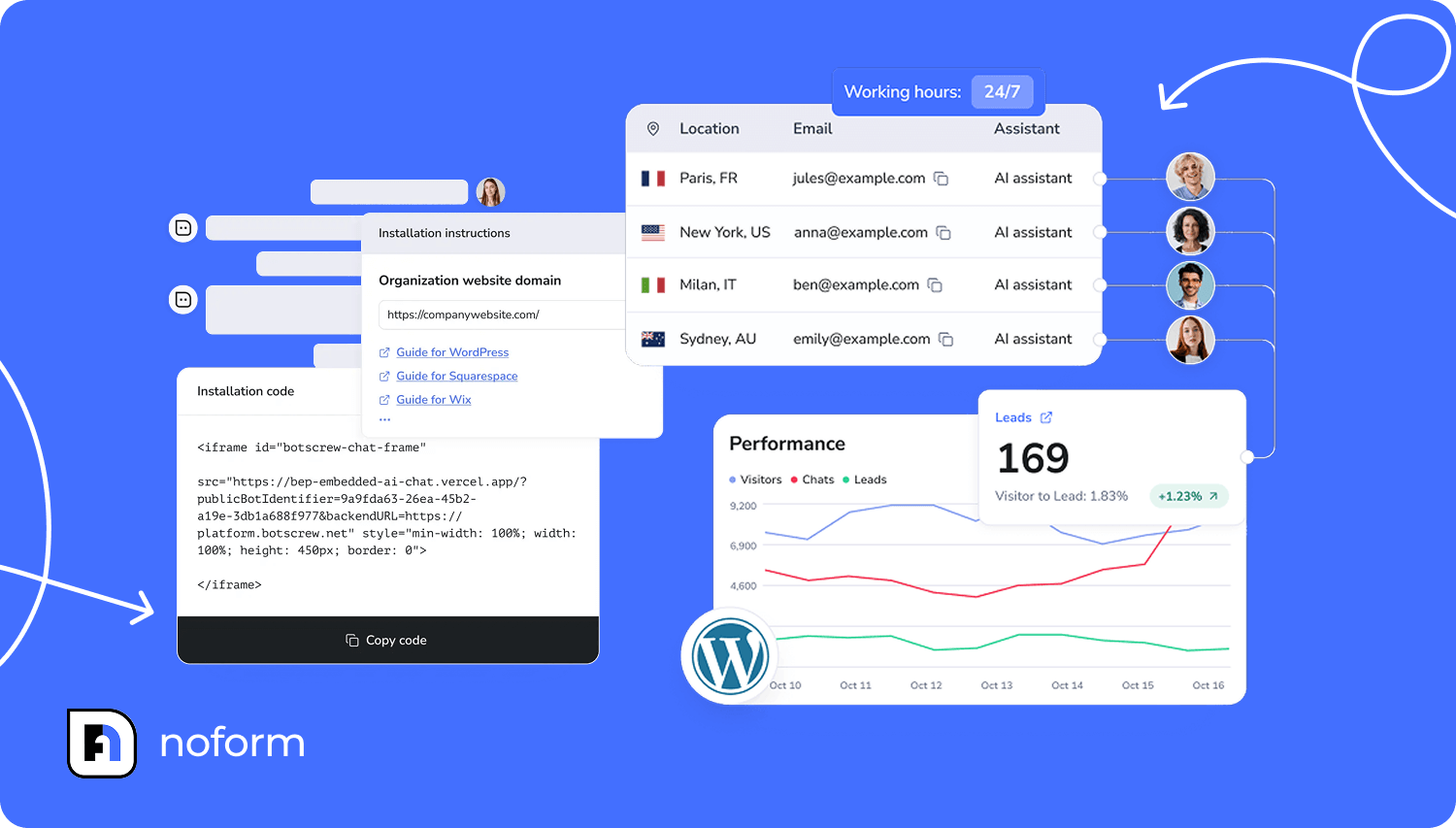
- Improved lead quality: Chatbots use automated lead scoring to prioritize high-value leads based on user responses. By asking strategic questions and collecting key details such as the company size, industry, and even the buying timeline, they help your team prioritize leads based on their urgency, stage of their buying process, overall fit, and the potential value of the sale for your company.
- Personalized initial interactions: AI bots adapt questions and content based on user behavior (e.g. pages viewed) and express needs (e.g. budget). For example, a SaaS chatbot could recommend the most relevant pricing plan to a small business browsing the pricing page or ask more technical questions if a visitor views developer documentation, making the experience more relevant and increasing the chance of conversion.
- Data collection and analysis: Bots can collect valuable insights like common questions, user behavior patterns, and engagement metrics to inform your marketing strategies down the line. These insights can be an invaluable resource for improving the customer experience or even determining the direction for the company’s positioning, products, and future goals.
- Cost efficiency: Chatbots are an incredibly cost-effective solution for capturing leads, allowing you to significantly reduce operational costs by handling repetitive tasks like FAQs, all while freeing up sales teams to focus on high-potential prospects that need a more personal touch.
- Automation of routine interactions: Since a chatbot doesn’t have a limit in terms of how many people it can interact with at once, it’s the perfect solution for automating routine tasks that would be hard to cover otherwise. For example, a financial service bot could handle frequent account setup questions, allowing human agents to focus on more complex product consultations.
Key features and capabilities of AI customer acquisition
Chatbots use a variety of powerful features to improve customer experiences and drive lead generation, contributing to better customer lifecycle management and more effective marketing efforts.
Proactive engagement
Chatbots can initiate conversations with visitors based on their behavior, such as time on page or scroll depth, personalizing the interactions based on the page’s context and other cues that might give insights into what the user might respond to.
This feature plays a critical role in helping businesses stay ahead of competitors who rely solely on passive lead capture forms.
Natural Language Processing (NLP)
Thanks to Natural Language Processing (NLP) and machine learning, chatbots understand and respond to natural language queries, making the experience feel more human and conversational.
This not only improves user engagement but also increases the likelihood of conversion by making the conversation feel more personal and relevant. This level of personalization can boost customer satisfaction and paves the way for a positive impression of your brand.
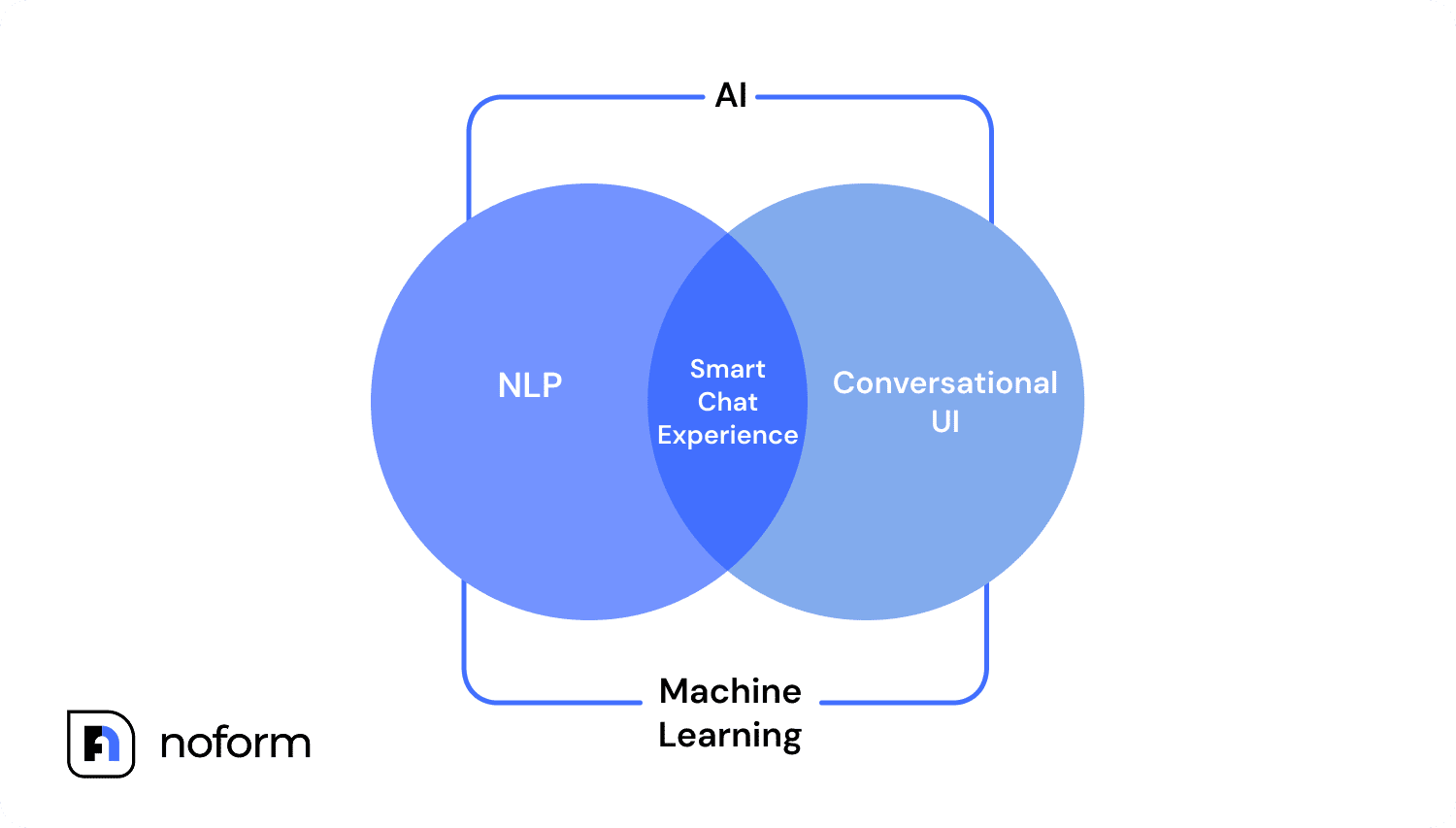
Lead capture and CRM integration
AI chatbots can collect essential customer data like names, emails, company details, and even purchase intent, so that your sales team has everything they need to approach the lead with confidence. These tools help businesses better understand customer needs across various touchpoints.
What’s more, NoForm AI chatbot integrates seamlessly with many of the most popular CRM systems via Zapier and Make, ensuring your sales team receives qualified leads in real-time, ready to follow up without manual data entry.
Adaptive questioning and branching logic
Powered by conversational AI, chatbots use adaptive questioning and branching logic to deliver a personalized experience.
These conversations can be tailored based on the individual behavior and responses, helping to build an accurate customer profile and improve audience segmentation. They also help improve the efficiency of your marketing system and sales funnel by filtering out unqualified leads early on.
Content and resource sharing
Chatbots can provide instant access to case studies, product recommendations, downloadable resources, and FAQs, offering actionable content based on user needs to help move promising prospects further down the customer acquisition funnel.
This is particularly valuable for B2B software companies like financial service providers, who need to educate their visitors to turn them into high-potential prospects that the sales team can take over.
Appointment and demo scheduling
Chatbots can help avoid email back-and-forth by providing a direct link to schedule demos, book consultations, or set up meetings, all within the chat interface.
This dramatically reduces friction in the customer ordering process and makes it incredibly easy for potential customers to take the next step, increasing the conversion rate from visitor to booked meeting.
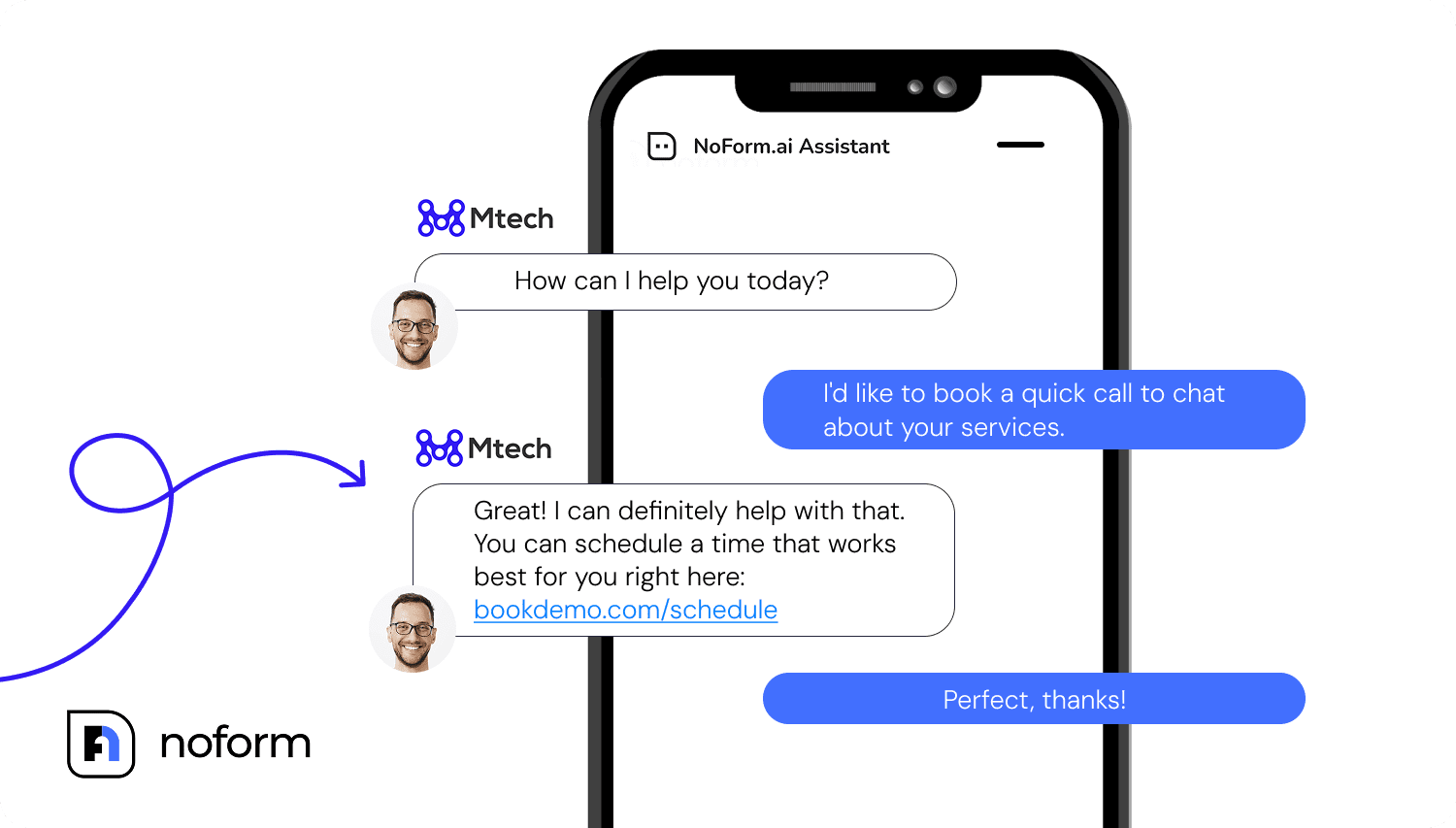
Seamless lead handoff
Being able to transition the query to a human agent is crucial when dealing with more complex issues, so that the chatbot doesn’t provide incorrect information or leave the query unresolved.
Smart chatbots make it easy to collect details from the site’s visitors, which can then be quickly picked up by people who can provide answers in situations that aren’t yet part of the bot’s training.
Real-world use cases across industries
The best way to see how an AI-powered chatbot can drive customer acquisition is to explore real-world use cases that illustrate its impact. These demonstrate the potential of chatbots to transform how businesses communicate.
Website lead capture
One of the most popular benefits for businesses is using a chatbot solution to engage website visitors in real time. For example, Dog Gone Taxi leveraged an AI-powered virtual assistant to greet visitors, answer common questions, and collect vast amounts of customer information like names, emails, and service requirements, automating lead qualification in the process.
This conversational assistant was able to boost performance by ensuring instant responses based on user behavior, converting high-potential prospects and providing a significant boost in conversion rate.
Content marketing support
Bots in marketing are increasingly used to gate content like eBooks or webinars. Instead of relying on a traditional method like static forms, businesses can ask qualifying questions through a conversational AI flow, offering personalized content suggestions that directly solve user problems while educating them.
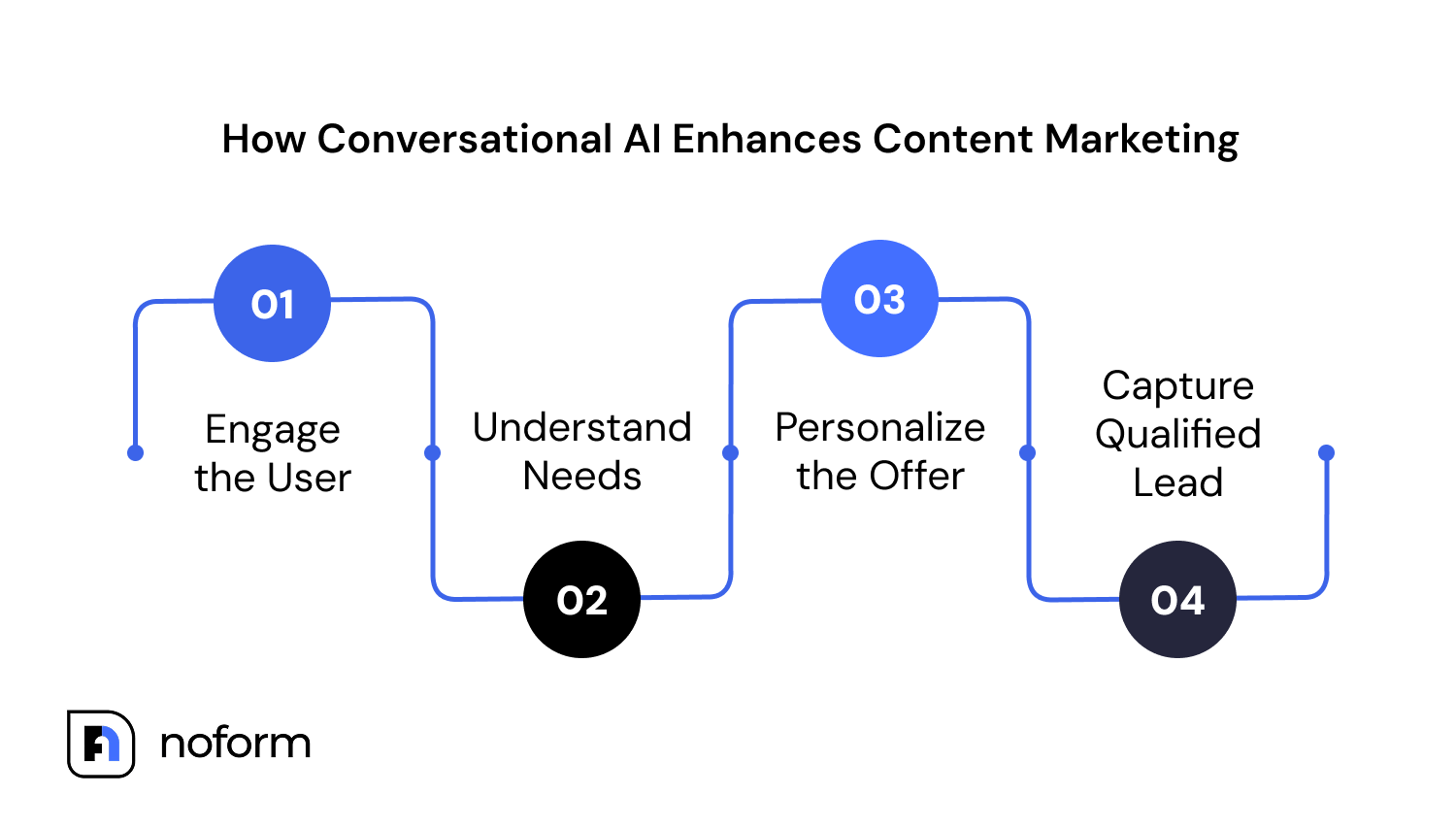
For example, a B2B software company might use a chatbot solution to ask about company size, job role, or main pain points before granting access to valuable resources. This helps capture leads that are already pre-qualified, facilitating audience segmentation based on the amount of customer information gathered during the interaction.
Product recommendations and upselling
Ecommerce businesses often use AI chatbot technology to guide potential customers toward relevant products based on individual behavior and user preference.
For example, when a visitor browses a category page, the bot can suggest premium or entry-level products based on the information the user provides. It can even upsell complementary items that fit the user’s needs, increasing the average order value through a personalized experience that feels natural and reflects emerging consumer expectations.
Demo scheduling and booking
For businesses selling complex solutions, like B2B software companies, scheduling a demo is often a critical role in the sales funnel. An AI-powered assistant can ask questions like “What’s your team size?” or “What are your primary goals?”, and can then integrate with automation service providers like Calendly to book a meeting instantly.
This improves acquisition efficiency by reducing friction in the customer journey, giving your team the best chance of closing these leads during the meeting.
Industry-specific applications
Beyond these more general use cases, here are industry-specific applications that can be incredibly useful:
- eCommerce: Help potential customers with product discovery, pre-purchase FAQs, and general questions about the best solutions for their needs.
- SaaS: Qualify high-potential leads by asking relevant questions and suggesting plans or trial options.
- Real estate: Handle customer interactions like property inquiries and schedule virtual or in-person viewings based on user behavior and location.
- Education: Support current customers and new prospects by answering admissions FAQs, guiding them through applications, and scheduling campus tours or virtual info sessions.
- Finance: Assist users in learning about banking product options, answering FAQs on loans or investments, and supporting account setup.
These use cases reflect a broader future trend in how AI will continue to impact the business reality of digital customer acquisition.
Best practices for implementing AI in customer acquisition
To fully unlock the transformative potential of an AI chatbot, it’s essential to implement it with the right strategy. Here are a few of the best practices to help businesses solve customer acquisition challenges with chatbots.
Define clear acquisition goals
Start by aligning your chatbot implementation with your business goals. For example, set specific objectives like “Our chatbot should qualify 200 leads per month with a 20% demo booking rate.”
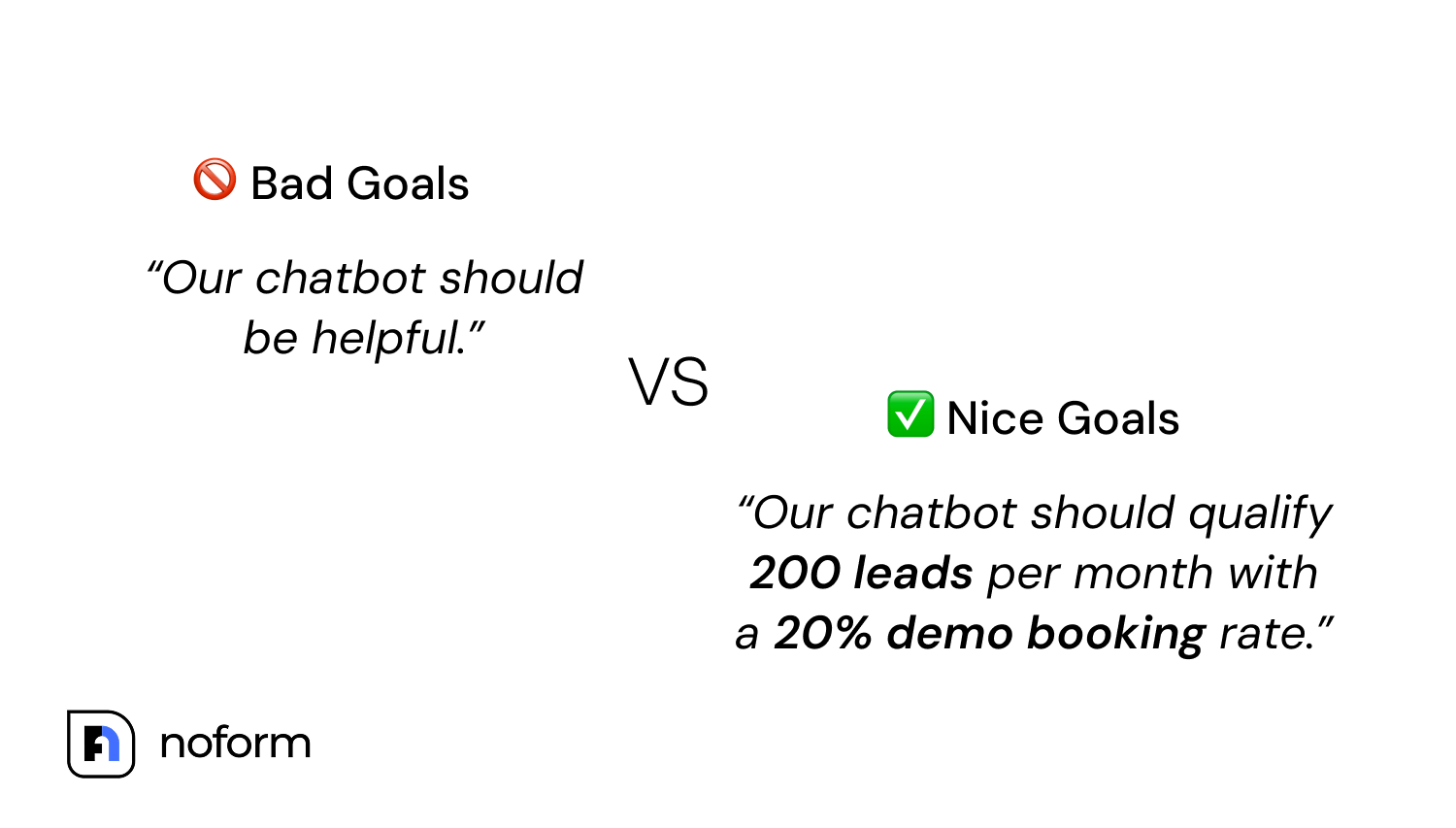
This helps ensure your chatbot solution delivers benefits for business that are aligned with your marketing strategies and can be measured for ongoing optimization.
Understand your audience
Effective personalization based on your audience is an essential part of chatbot success. Customize the language, tone, and conversation flow to match your target audience and its various segments.
Use the customer information you already have, such as user behavior and other customer data, to personalize messaging. You can then refine your chatbot based on the insights it can collect during actual customer interactions helping anticipate future behavior.
Design engaging conversational flows
Your AI-powered virtual assistant should be able to communicate in a way that’s natural and engaging. Use conversational AI’s branching logic to create flows that reflect the individual preferences of each visitor, anticipating their needs and guiding them to the next step in their customer journey.
For example, a real estate chatbot could ask, “Are you looking to buy or rent a property?” and then adjust the conversation and its flow accordingly.
CRM and marketing tool integration
Connect your chatbot with your CRM system and streamline various parts of the lead capture and customer acquisition processes.
This helps ensure qualified leads are captured in real time and made available to your sales team, reducing manual work, all while also improving the user experience.
Train and optimize your AI bot
To get the most out of your chatbot, it’s crucial to treat it as an evolving system, not a set-it-and-forget-it tool. Leverage built-in AI tools and analytics to continuously monitor customer interactions and performance data.
For example, if visitors frequently abandon the chat after a certain question, this may signal that the conversation flow needs to be refined to better align with the user’s needs.
Promote your chatbot
Even the most advanced AI chatbot won’t deliver results if users don’t know it’s there. Make sure your chatbot solution is highly visible on high-intent pages like your pricing page, product listings, or contact page.

These touchpoints attract potential customers who are already considering action, making them perfect opportunities to enhance customer engagement and capture qualified leads, ultimately building loyal customer relationships.
Manage human handoff
One of the most important parts of chatbot deployment is ensuring a seamless transition from automated conversations to human follow-up. Even though chatbots can handle many different scenarios, there comes a point where human involvement is essential for handling complex tasks or closing deals.
The best chatbots must be able to effectively hand off conversations to human agents, either by transferring directly or by capturing contact details so that human agents can reach out promptly.
Why NoForm AI is the right chatbot for driving customer acquisition
If you’re looking for a powerful tool to help drive customer acquisition and boost your conversion rate without a complicated setup, NoForm AI is one of the strongest comprehensive solutions on the market you can go with.
Here are just a few powerful features you get when you choose NoForm AI:
- Easy no-code setup: Deploy your AI chatbot instantly by simply copying and pasting the code to platforms like WordPress, Framer, Wix, Webflow, and more.
- Lead qualification and capture: Guide potential customers through qualifying conversations to capture qualified leads, with intuitive and responsive conversational AI that adapts to the user’s needs, reads various cues to determine tone and urgency, and continually learn to provide better experiences. These actionable conversations help you identify your ideal customer profile in real time.
- Full customization: Personalize the chatbot’s branding, messaging, and behavior to align with your business goals and customer needs.
- Multilingual support: Communicate with a global customer base by supporting diverse language preferences, driving results for your business worldwide.
- Data-driven insights: Leverage analytics to uncover customer behavior trends, helping you optimize your marketing strategies and website experience. This use of artificial intelligence technology not only enhances engagement but also reduces your customer acquisition cost over time.
With NoForm AI, you can boost your customer acquisition efforts using proactive engagement based on user behaviors, tailoring personalized experiences to each visitor’s preferences.
A great example of how NoForm AI can work in real-world scenarios is Dog Gone Taxi. It leveraged NoForm AI to increase the visitor-to-lead conversion rate by 37%, engage more than 50 thousand website visitors, reduce wait times, and increase the overall satisfaction of customers.
If you’re ready to take advantage of chatbots to generate leads and close more sales, get started with NoForm AI today!

